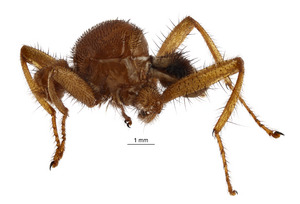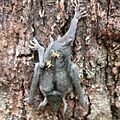New Zealand bat fly facts for kids
Quick facts for kids New Zealand bat fly |
|
|---|---|
 |
|
| Mystacinobia zelandica holotype NZAC04019196 (male), dorsal view | |
 |
|
| Lateral view | |
| Scientific classification | |
| Genus: |
Mystacinobia
|
| Species: |
zelandica
|
The New Zealand bat fly (Mystacinobia zelandica) is a tiny, wingless insect. It lives closely with the New Zealand lesser short-tailed bat. This fly is special because it's the only known insect that lives with these bats. It's a true fly, part of the order Diptera. This unique fly is found only in New Zealand.
Contents
About the New Zealand Bat Fly
New Zealand bat flies are small, usually 4 to 9 millimeters long. Both male and female flies do not have wings. They are also blind. Their legs are long and bristly, looking a bit like a spider's legs.
Their legs have special claws. These claws might help them "swim" through the bat's fur. Male bat flies are larger than females. They also look quite different from the females.
How Scientists Found Them
The Mystacinobia fly was first discovered in 1958. The first specimen was collected in 1962. It fell out of the fur of a short-tailed bat. A zoologist named P. D. Dwyer was looking after the bat.
In 1973, a very tall kauri tree fell down. This tree was in the Omahuta Kauri Sanctuary in Northland. A large group of short-tailed bats lived in it. The next day, a dead bat was found with three bat flies on it.
This was a chance to study live bat flies. But the bats left their fallen home quickly. Scientists from the DSIR couldn't get there in time.
Two years later, in 1975, another kauri tree fell. This happened during Cyclone Alison. This time, scientists were able to collect many bat flies. They studied their bodies and watched their behavior. This helped them officially describe and name the new species.
Life in the Bat Roost
Almost everything about this fly is unusual. Most bat flies drink blood from bats. But the New Zealand bat fly does not. Instead, it eats guano, which is bat droppings.
These flies live in groups or colonies. The female flies lay their eggs together. They create large shared nurseries for eggs and young larvae. These nurseries need to be warm, over 30° C, for the young to grow. Adult female flies even groom the larvae and each other.
There's also a special group of older male flies. They live past their normal age for having babies. These older males act like "soldier guards" for the colony. They make a high-pitched buzzing sound. This sound seems to keep the bats from flying too close to the fly colony.
Bats eat insects, so the flies could be eaten by their hosts. The buzzing of these older males helps protect the flies. To move to new places, bat flies ride on their bat hosts. Up to 10 flies can be found on one bat when it leaves its home.
Naming and Family Tree
Entomologist Beverly Holloway named and described the New Zealand bat fly. She placed it in its own unique family, Mystacinobiidae. She also gave it its own genus, Mystacinobia. This means it was the only known member of both its family and genus.
Later, DNA studies showed that these flies are very old. They are a distinct and ancient group within the superfamily Oestroidea. This group includes flies like flesh flies and blow flies.
The ancestors of the short-tailed bat lived in Australia about 20 million years ago. Scientists are not sure if the New Zealand bat fly first evolved in Australia or New Zealand. It might have traveled across the Tasman Sea with its bat hosts. Or it could have arrived from a forested Antarctica long ago.
Images for kids
-
New Zealand bat flies (Mystacinobia zelandica) on a young short-tailed bat (Mystacina tuberculata) in Fiordland




